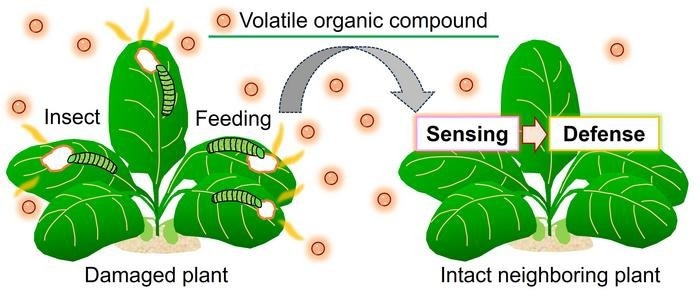Plants release volatile organic compounds (VOCs) into the atmosphere when they experience mechanical damage or insect attacks. Nearby undamaged plants detect these emitted VOCs as signals of potential danger, prompting them to activate defense mechanisms against imminent threats.
 Plants release VOCs into the atmosphere when damaged by insects. Intact neighboring plants sense VOCs and activate pre-emptive defense responses against the insects. Image Credit: Masatsugu Toyota/Saitama University.
Plants release VOCs into the atmosphere when damaged by insects. Intact neighboring plants sense VOCs and activate pre-emptive defense responses against the insects. Image Credit: Masatsugu Toyota/Saitama University.
This form of airborne communication between plants through VOCs was initially documented in 1983 and has been observed in over 30 different plant species. Nonetheless, the specific molecular mechanisms responsible for perceiving these VOCs and triggering the plant's defense responses have yet to be fully understood.
Unveiling the Invisible Conversation
Led by Professor Masatsugu Toyota from Saitama University in Japan, the research team employed real-time visualization techniques to observe plant-plant communication through VOCs. Their work has shed light on the process by which plants uptake these VOCs and subsequently activate defense responses that are dependent on Ca2+, all in preparation to ward off potential threats in the future.
This groundbreaking research was published in Nature Communications on October 17, 2023. The work was spearheaded by Yuri Aratani, who was a Ph.D. student, and Takuya Uemura, who served as a postdoctoral researcher, both in Professor Masatsugu Toyota's laboratory. They also collaborated with Professor Kenji Matsui at Yamaguchi University in Japan.
We constructed equipment to pump VOCs emitted from plants fed by caterpillars onto undamaged neighboring plants and combined it with a wild-field, real-time fluorescent imaging system.”
Masatsugu Toyota, Professor, Saitama University
The innovative experimental arrangement enabled the visualization of fluorescence bursts within a mustard plant (Arabidopsis thaliana) following its exposure to VOCs released by insect-damaged plants.
In this setup, the plants were equipped with fluorescent protein sensors designed to detect intracellular Ca2+. Consequently, any fluctuations in intracellular Ca2+ levels were tracked by monitoring changes in fluorescence.
In addition to insect attacks, VOCs released from manually smashed leaves induced Ca2+ signals in undamaged neighboring plants.”
Masatsugu Toyota, Professor, Saitama University
In their quest to pinpoint which types of VOCs trigger Ca2+ signals in plants, Professor Toyota's team of researchers explored various VOCs that are recognized for provoking defense responses in plants.
Their investigation revealed that two VOCs, namely (Z)-3-hexenal (Z-3-HAL) and (E)-2-hexenal (E-2-HAL), both of which are six-carbon aldehydes, have the capability to induce Ca2+ signals in Arabidopsis. These airborne chemicals, with grassy scents, fall into the category of green leaf volatiles (GLVs) and are emitted by plants that have undergone mechanical damage or herbivore attacks.
Exposing Arabidopsis to Z-3-HAL and E-2-HAL resulted in the increased expression of defense-related genes. To explore the connection between the Ca2+ signals and the defense responses, the researchers treated Arabidopsis with the Ca2+ channel inhibitor, LaCl3, and the Ca2+ chelating agent, EGTA.
The application of these chemicals effectively suppressed both the Ca2+ signals and the activation of defense-related genes. This provides strong evidence that Arabidopsis detects GLVs and initiates defense responses in a manner that is dependent on Ca2+.
Guard Cells: The Gateway to Awareness
The researchers additionally pinpointed the specific cells that displayed the Ca2+ signals in response to GLVs by creating transgenic plants that expressed fluorescent protein sensors exclusively in guard, mesophyll, or epidermal cells.
When exposed to Z-3-HAL, Ca2+ signals were initially generated in the guard cells within roughly 1 minute. Subsequently, mesophyll cells exhibited these signals, while epidermal cells showed a slower generation of Ca2+ signals. Guard cells are bean-shaped cells found on the surfaces of plants and play a vital role in forming stomata, which are small pores connecting the plant's inner tissues with the atmosphere.
“Plants do not possess a ‘nose,’ but stomata serve as a plant gateway mediating rapid GLV entry into interspaces in leaf tissues,” says Toyota.
They discovered that prior treatment with abscisic acid (ABA), a phytohormone recognized for its capacity to close stomata, lessened Ca2+ reactions in wild-type leaves. Conversely, mutants with compromised ABA-triggered stomatal closure maintained regular Ca2+ signals in their leaves even when exposed to ABA.
We have finally unveiled the intricate story of when, where, and how plants respond to airborne 'warning messages' from their threatened neighbors. This ethereal communication network, hidden from our view, plays a pivotal role in safeguarding neighboring plants from imminent threats in a timely manner.”
Masatsugu Toyota, Professor, Saitama University
This groundbreaking research not only enhances the understanding of the fascinating realm of plants but also emphasizes the extraordinary mechanisms that nature has endowed them with to flourish and adjust in challenging circumstances.
The profound significance of these discoveries extends well beyond the realm of plant science, providing insights into the intricate web of life on the planet.
Source:
Journal reference:
Aratani, Y., et al. (2023). Green leaf volatile sensory calcium transduction in Arabidopsis. Nature Communications. doi.org/10.1038/s41467-023-41589-9.